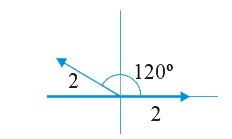Maximum and minimum magnitudes of the resultant of two vectors of magnitudes P and Q are in the ratio 3:1. Which of the following relation is true?
P=2Q
P=Q
PQ=1
none of these
The correct Answer is:A
To solve the problem, we need to analyze the relationship between the maximum and minimum magnitudes of the resultant of two vectors P and Q given that their ratio is 3:1.
1. Understanding Resultant Vectors:
The resultant R of two vectors P and Q can be expressed as:
R=√P2+Q2+2PQcosθ
where θ is the angle between the two vectors.
2. Maximum and Minimum Values of Resultant:
- The maximum value of R occurs when θ=0∘ (vectors are in the same direction):
Rmax=P+Q
- The minimum value of R occurs when θ=180∘ (vectors are in opposite directions):
R_{\text{min}} = |P - Q| = P - Q \quad \text{(assuming P > Q )}
3. Setting Up the Ratio:
According to the problem, the ratio of the maximum to minimum resultant is given as:
RmaxRmin=31
Substituting the expressions for Rmax and Rmin:
P+QP−Q=3
4. Cross-Multiplying:
Cross-multiplying gives:
P+Q=3(P−Q)
5. Expanding the Equation:
Expanding the right side:
P+Q=3P−3Q
6. Rearranging the Equation:
Rearranging the terms to isolate P and Q:
P+Q+3Q=3P
P+4Q=3P
4Q=3P−P
4Q=2P
7. Final Relation:
Dividing both sides by 2 gives:
2Q=P
or
P=2Q
Conclusion:
Thus, the relation that holds true is:
P=2Q
The resultant R of two vectors P and Q can be expressed as:
R=√P2+Q2+2PQcosθ
where θ is the angle between the two vectors.
- The maximum value of R occurs when θ=0∘ (vectors are in the same direction):
Rmax=P+Q
- The minimum value of R occurs when θ=180∘ (vectors are in opposite directions):
R_{\text{min}} = |P - Q| = P - Q \quad \text{(assuming P > Q )}
According to the problem, the ratio of the maximum to minimum resultant is given as:
RmaxRmin=31
Substituting the expressions for Rmax and Rmin:
P+QP−Q=3
Cross-multiplying gives:
P+Q=3(P−Q)
Expanding the right side:
P+Q=3P−3Q
Rearranging the terms to isolate P and Q:
P+Q+3Q=3P
P+4Q=3P
4Q=3P−P
4Q=2P
Dividing both sides by 2 gives:
2Q=P
or
P=2Q
Thus, the relation that holds true is:
P=2Q
Similar Questions
Resultant of two vector of equal magnitude A is
View SolutionThe maximum and minimum magnitudes of the resultant of two vectors are 23 units and 7 units respectively. If these two vectors are acting at right angles to each other, the magnitude of their resultant will be
View SolutionThe maximum and minimum magnitudes of the resultant of two vectors are 23 units and 7 units respectively. If these two vectors are acting at right angles to each other, the magnitude of their resultant will be
View SolutionThe ratio of maximum and minimum magnitude of the resultant of two vectors →A and →B is 3:2. The relation between A and B is
View SolutionThe maximum and minimum magnitude of the resultant of two given vectors are 17 units and 7 unit respectively. If these two vectors are at right angles to each other, the magnitude of their resultant is
View SolutionThe ratio of maximum and minimum magnitudes of the resultant of two vectors →a and →b is 3:1. Now, |→a| is equal to
View SolutionThe ratio of maximum and minimum magnitudes of the resultant of two vectors →a and →b is 3:1. Now, |→a| is equal to
View SolutionFind the magnitude and direction of the resultant of given vectors
 View Solution
View SolutionThe maximum and minimum magnitudes of the resultant of two forces are 5 N and 5N respectively. Find the magnitude of resultant force when act orthogonally to each other.
View SolutionThe resultant of two vectors of magnitude 3 units 4 units is 1 unit. What is the value of their dot product. ?
View Solution

